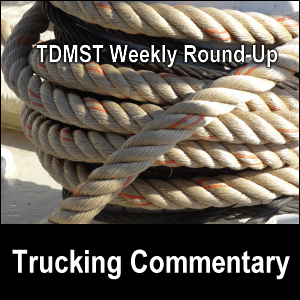This is the TDMST Weekly Round-Up of news affecting professional truck drivers, written by Vicki Simons for the week ending December 2, 2017.
We welcome your comments, thoughts and feedback on the items of your choice below.

This issue of TDMST Weekly Round-Up will focus solely on the Electronic Logging Device (ELD) mandate.(*)
There are numerous articles online and in print about the December 18, 2017, deadline to comply with the Electronic Logging Device (ELD) mandate — as well as the December 4, 2017, set of protests against the mandate.
One thing is clear: A machine that records the hours worked is dependent upon the one who is using the machine to input accurate information.
If a professional truck driver falsifies his/her electronic log to record work time as if it was not work time, a series of things will most likely happen:
1. The problems associated with the current way that most truckers are paid will not change;
2. The problems associated with the current way that some shippers and receivers operate will not change;
3. The problems associated with the current Hours of Service (HOS) regulations will not change; and
4. The problems associated with truck and trucker safety will not change.
Let me paint a scenario and share what’s wrong.
Let’s assume that “John” arrives at Big Shipper on time but the load he is to pick up isn’t ready to be loaded on his truck.
John has to wait 6 hours in a parking place on the property and then has to move his truck into the dock.
Well, he can’t list the 6 hours as part of his sleeper berth time because his sleep time — according to the HOS regulations — has to be 10 hours.
Not only that, but depending upon when John started driving to the shipper, he may not be able to move his truck after 6 hours of waiting anyway.
If he started driving any farther back on the clock than 5 hours before he arrived at the shipper, he is not supposed to drive his truck at all (because of the 11-hour window in the HOS).
What is John supposed to do?
Will he be paid for his time waiting?
In my opinion, if all drivers simply agreed not to falsify their logs and refused to move their trucks when their Hours of Service demanded it, there would soon be change!
Freight wouldn’t move, trucks would be backed up, chaos would ensue.
What about being paid?
Truckers are the ones who are operating the equipment they drive.
If they simply refuse to drive when they are not supposed to drive, yes, it may hurt on the basis of cents per mile for a while, but the method by which they are paid to do their jobs will most likely change.
Pressure will need to be put upon the parties who are responsible for trucker delays: shippers and receivers.
Back in the September 30, 2017, issue of TDMST Weekly Round-Up, I wrote,
Some years back, I seem to recall that one country (Japan?) had an on-time air transportation efficiency that was extremely high. I realize that this is not the same as truck transportation. However, if extremely high efficiency has been done in one industry, why can’t the principles of that industry be applied to others?
What I’m saying is that
– if the Hours of Service regulation was more flexible;
– if shippers and receivers upped their games regarding drastically reducing loading and unloading times; and
– if truckers were truly paid what their skill sets and job responsibilities were worth;
then trucker income would go up regardless of electronic logs.
I took time to look up some info about air transportation in Japan and found a couple of articles:
– According to one article, “Emirates [Japan] has invested in one of the best flight planning systems available, to carefully plan flights and optimise routes. By working with our partners at Airservices Australia (ASA) to use non-fixed (flexible) air traffic routes that are optimised for the prevailing weather, we save time, fuel and emissions — every day.”
(https://www.emirates.com/english/about-us/our-planet/ no longer online)
– According to this February 23, 2010, article, “Japan Airlines and ANA topped the rankings of major carriers’ on-time records by FlightStats, a platform by Portland, Ore. company Conductive Technology. … What’s particularly special about Japan Airlines’ 91% on-time record is that it achieved this with more than 215,000 flights during the year.”
Again, I think that it is possible that manufacturing, shipping and receiving in the USA can be made more efficient.
Furthermore, if truckers are only being paid to drive — as in being paid cents per mile — then this basically says that the rest of the time that they are on duty not driving is worthless.
This patently unfair system needs to change.
Let’s look at another perspective of the ELD mandate:
Supposedly, this move is going to save lives.
Do you remember what happened in 2013 when the Hours of Service regulation was changed, purportedly to “save lives”?
I wrote a guest blog here on August 1, 2013, citing, “FMCSA estimated that these new safety regulations will save 19 lives and prevent about 1,400 crashes and 560 injuries each year.”
Has that happened?
According to a November 29, 2017, article, “Data released by the National Transportation Safety Board (NTSB) on November 21 revealed 2,030 more people died in transportation accidents in 2016 than in 2015, with highway fatalities accounting for 95% of all transportation fatalities in 2016.”
OK, what about large truck crashes?
According to Data and Statistics from the FMCSA:
– “Over the past year (from 2012 to 2013): The number of large trucks involved in fatal crashes increased by 2 percent, from 3,825 to 3,906, and the vehicle involvement rate for large trucks in fatal crashes (vehicles involved in fatal crashes per 100 million miles traveled by large trucks) remained steady at 1.42.” (link)
– “Over the past year (from 2013 to 2014): The number of large trucks involved in fatal crashes decreased by 5 percent, from 3,921 to 3,744, and the large truck involvement rate (large trucks involved in fatal crashes per 100 million miles traveled by large trucks) declined by 6 percent, from 1.43 to 1.34.” (link)
– “Over the past year (from 2014 to 2015): The number of large trucks involved in fatal crashes increased by 8 percent, from 3,749 to 4,050, and the large truck involvement rate (large trucks involved in fatal crashes per 100 million miles traveled by large trucks) increased by 8 percent, from 1.34 to 1.45.” (link)
In my October 14, 2017, issue of TDMST Weekly Round-Up, in point #7, I cited an October 10, 2017, article that stated:
“As to fatalities resulting from crashes involving large trucks, the [National Highway Traffic Safety Administration] recorded a 5.4% jump in those over 2015, the highest since 2007.”
So, annually over the period from 2012 to 2016, fatal crashes involving large trucks was up by 2 percent, down by 5 percent, up by 8 percent, and up by 5.4%, for a net increase of 10.4%.
What has been happening?
Are the large trucks at fault in all or even most of these fatal crashes involving large trucks?
Ohio doesn’t represent the entire USA, of course, but we read in a November 22, 2017, article that “Based on statistics from 2016, the Ohio DOT confirmed that the truck driver wasn’t at fault in about 75 percent of fatality crashes involving a commercial motor vehicle.”(a)
Obviously, something needs to be done to prevent the fatal crashes for which truckers are at fault.
But the focus needs to be on the greater of the two contributors, which is not the commercial motor vehicles or their drivers.
Imagine the uproar that would ensue if non-commercial motor vehicles were all required to have monitoring systems in them!
I was very pleased to read in a November 30, 2017, article that Indiana Attorney General Curtis Hall sent a letter to the FMCSA, asking “for a delay on the mandate, citing the ‘self-certification’ provision in the current regulation that allows device manufacturers to claim their ELDs are compliant, without any government or third-party verification.”(b)
He wrote that “with no effective procedures seemingly yet developed to provide oversight over such self-certifying — drivers and operators are left without any way of ascertaining which brands and models of devices ultimately will pass muster … They must fly blindly into investing in products they are being required to purchase.”
Another aspect of the ELD mandate that has not been addressed appropriately is the possibility that ELDs can be hacked or operated remotely without driver input.
We already know that reports about compliance can be sent to 2 entities other than the trucker!
As far as verification is concerned, one wonders if trucking companies that have been using ELDs for some time are any “safer” than trucking companies that haven’t been using them.
According to one resource I read last night, a large trucking company that uses ELDs has a poor safety record!
What about the economic impact of ELDs?
Well, first there is the cost of the device, then the ongoing cost of the service, and then the cost of training a driver on how to use the device and service.
(I wouldn’t trust any company that doesn’t charge a monthly fee for service, because there will be no motivation to keep the service compliant. Just saying…)
Will the ELD save time and money in the long run?
Supposedly, “the net benefits of ELDs outweigh the costs with expected paperwork savings of over $1.6 billion annually” (link).
With 3.5 million trucks in operation, that assumes an annual savings per truck of over $457 per year. Is that reasonable?
What about the ongoing cost of the ELD service?
If 3.5 million trucks pay $50 per month, that will be an outlay of $175 million per month.
Multiply that by 12 months for an annual cost of $2.1 BILLION in service fees — after the cost of the equipment and installation!
(That’s whole lot of money that can be put into increasing driver pay.)
What about the cost of lives?
If the ELD mandate is estimated to save 26 lives every year — at an ongoing cost of $2,100,000,000 per year — then that means that each of those lives is worth $80,769,230.76 annually.
At $80,769,230 per year, that’s about $221,285 per day.
Why aren’t truckers being treated and paid as if they weren’t worth that much money?
So, this issue is about far more than just moving a commercial driver’s Record of On Duty Status (RODS) from paper to an electronic format.
This is about power and control.
And it’s also a move toward replacing professional truck drivers with autonomous trucks.
The only problem is that if 75% of the fatal crashes involving large trucks aren’t the truck driver’s fault, then in such situations, it won’t matter if the “operator” of a truck is a human or a machine.
There will still be truck crashes because the fault lies with the operator of the other vehicle.
Read more about the December 4, 2017, protests against the ELD mandates here(c) and here.
My husband Mike and I wish you — and all professional truck drivers — safe travels and lots of money saving opportunities on the road.
Return from TDMST Weekly Round-Up: 2017.12.02 to our TDMST Weekly Round-Up Trucking Commentary or our Truck Drivers Money Saving Tips home page.
< Note: This page was updated on December 3, 2017, to correct annual costs versus monthly costs of ongoing ELD service.
* Note: This page was updated on December 3, 2017, to correct annual costs versus monthly costs of ongoing ELD service.
References:
a. www.landlinemag.com/Story.aspx?StoryID=71269#.WiIfHXZrzcs (no longer online)
b. www.landlinemag.com/Story.aspx?StoryID=71303#.WiIeUXZrzcs (no longer online)
c. www.landlinemag.com/Story.aspx?StoryID=71308#.WiIeUnZrzcs (no longer online)










